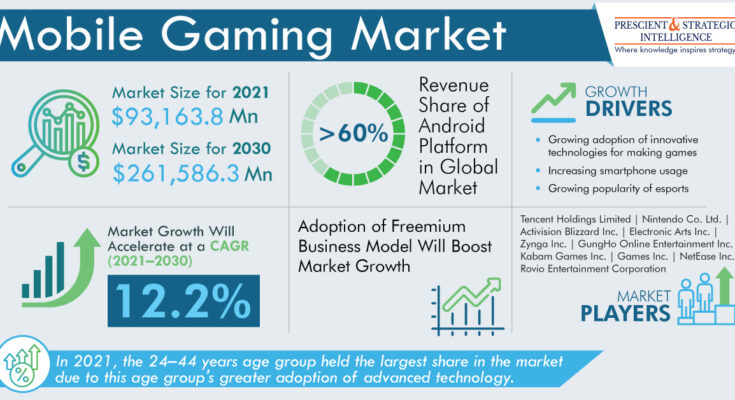In 2021, the mobile gaming market stood at $93,163.8 million, which is on the path to reaching a size of $261,586.3 million in 2030. The market is predicted to advance at a CAGR of 12.2% from 2021 to 2030, owing to the growing mobile usage and increasing acceptance of innovative technologies. Furthermore, the rising e-sports popularity will pave the way for a booming market. In addition, the access to higher data speeds would increase with the extensive use of the 5G technology, thus leading to a widening gaming audience.
Smartphones are playing a crucial role in the expansion of the global gaming market. This market is attaining scalability owing to the development of mobile games. The count of gamers is increasing tremendously with the rising disposable income of consumers, thus consequently driving their purchasing power, which enables them to buy smartphones. For instance, social media platforms, such as Instagram and Facebook, are deploying mobile games to enhance their advertising and marketing strategies.
The increasing adoption of technological advancements is leading to the mobile gaming market expansion. Cloud gaming is changing the gaming industry by providing better opportunities for game developers. A number of technological businesses and cloud gamers have accepted cloud gaming since it minimizes the memory space required to unlock the game on smartphones. Additionally, AR uses audio and video in a more-realistic setting, which captivates users. Furthermore, through a first viewpoint accompanied by a 360-degree vision, VR offers an extraordinary real-world experience to users. For instance, Pokémon Go and Ingress are among the widely searched AR games on app stores.
The adoption of a freemium business model is expected to advance at a mobile gaming market CAGR of over 10% from 2021 to 2030. Freemium games offer an additional benefit of making in-game purchases. The basic version of a freemium game is available for free; however, the player must pay for additional features or level upgrades. The payment can be made as per the preferences of gamers, as there are various payment mechanisms.
The largest share in the mobile gaming market was held by the 24–44 years age group in 2021. This may be attributed to the rapid adaptation to technical advances by this age bracket. Since this age group has people who are tech-savvy and keen to try new products, a major chunk of smartphone users lie in this category. The release of new smartphones with special features facilitates an enhanced user experience, which drives the mobile game downloads by this age group.
APAC will be a significant contributor to the mobile gaming market, owing to the increasing sale of smartphones, coupled with the bettering internet connectivity. The regional middle-class population is not only technologically sophisticated but also richer than before, which makes the region an appropriate investment hotspot. Moreover, India is on the path of promoting its beliefs and values through games. For instance, the Indian government, in collaboration with IIT Bombay, is planning to develop a center of excellence in gaming to boost the nation’s mobile gaming companies.
The skyrocketing demand for smartphone games and the popular gaming campaign #PlayApartTogether supported by WHO during COVID-19 have led to aggressive product development in this market.




